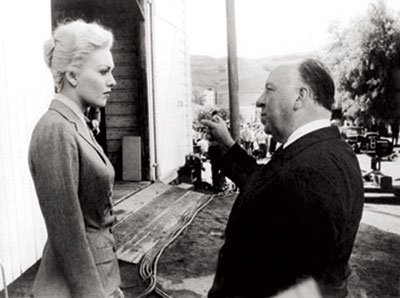Fifty years ago this Tuesday, the world’s most famous movie
director came to the South Valley to shoot key scenes of what’s now
considered a classic film. In the process of making
”
Vertigo,
”
Alfred Hitchcock made San Juan Bautista part of Hollywood
legend.
Fifty years ago this Tuesday, the world’s most famous movie director came to the South Valley to shoot key scenes of what’s now considered a classic film. In the process of making “Vertigo,” Alfred Hitchcock made San Juan Bautista part of Hollywood legend.
I’ve seen Hitchcock’s famous film several times and every viewing offers a brand-new experience – the true test of a great flick. “Vertigo’s” story is layered so heavily, it’s difficult to describe. On one level, it’s a psychological thriller about a San Francisco detective named “Scottie Ferguson” (darkly played by Jimmy Stewart) trying to overcome the acrophobia he developed after witnessing a fellow cop plunge to his death. On another level, it’s a complicated detective story involving a strange woman (played by Kim Novak) who might be possessed by the ghost of an aristocratic lady. It’s also the most disturbingly sinister love story ever put on celluloid – Stewart and Novak’s characters use each other almost ruthlessly in their deceptions and obsessions.
Basing the movie’s plot on a French novel titled “D’Entre les Morts” (“From Among the Dead”), Hitchcock set most of his story in photogenic San Francisco. But he needed an isolated California Spanish mission for a crucial plot twist taking place halfway through the film, and also for his story’s shocking climax. He selected San Juan Bautista’s mission church to provide the iconic setting for these two crucial scenes. And that choice made cinematic history.
The 58-year-old director had made more than 40 films when he arrived in San Juan Bautista on Oct. 9, 1957 to begin filming. The usually quiet village was thrown into a bustle as locals watched movie stars Stewart and Novak play out the drama of their tragic love story in San Juan Bautista’s historic state park and plaza as well as the town’s mission church. In the plaza’s livery stable, Novak and Stewart have a romantic moment on a horse buggy before Stewart chases her across the plaza into the church.
Both the mid-story plot twist and the climax scene take place in the mission’s “bell tower.” Unfortunately for Hitchcock, San Juan Bautista’s original tower was demolished years earlier from earthquake and dry rot damage. Legend has it Hitchcock first visited San Juan Bautista when the tower was still standing, so he and his crew were shocked to discover it gone when he returned to film “Vertigo.” But the inventive Hitchcock replaced the tower by using movie magic – a painted matte created this crucial architectural feature. He also had carpenters build a staircase at Paramount Pictures’s studio lot, and filmed the actors running up these stair steps to the top of the “tower.”
In the film, an inquest is held in a “courtroom” that overlooks San Juan Valley. Local viewers might think Hitchcock actually filmed this scene inside the upstairs chamber of the mission town’s Plaza Hall, but it was actually an exact replica studio set. Other local spots where Hitchcock shot “Vertigo” include the ocean bluffs of Cypress Point along Pebble Beach’s 17-Mile Drive, a redwood trail at Big Basin State Park, and the eucalyptus forest on Highway 101 near Aromas.
When it was first released on May 9, 1958, “Vertigo” failed to achieve box-office success – most probably because of its dark tone and highly complex story. The film also received mixed reviews from critics and won no Oscars. Hitchcock eventually took it out of circulation, but a technically renovated version came out in 1983.
Over the last 25 years, the film’s reputation and esteem grew with audiences. And film scholars praised it as Hitchcock’s best work by far. In 2002, a poll of notable critics placed “Vertigo” as “the second greatest film of all time.” (Orson Welles’s “Citizen Kane” ranked the top spot.) This year, the American Film Institute listed it at the No. 9 spot of the world’s “100 Greatest Movies.”
Psychological thriller. Detective mystery. Ghost story. Dark love story. “Vertigo” is all these things and more. But I like to see it as a cautionary tale about the dangers of looking back too deeply into history and becoming obsessed with the past. That’s why I think Hitchcock showed genuine genius in selecting South Valley’s own San Juan Bautista as the spot where the past and the present meet with tragic consequences. The historic mission town provided the perfect setting for director Hitchcock’s cinematic masterpiece.














